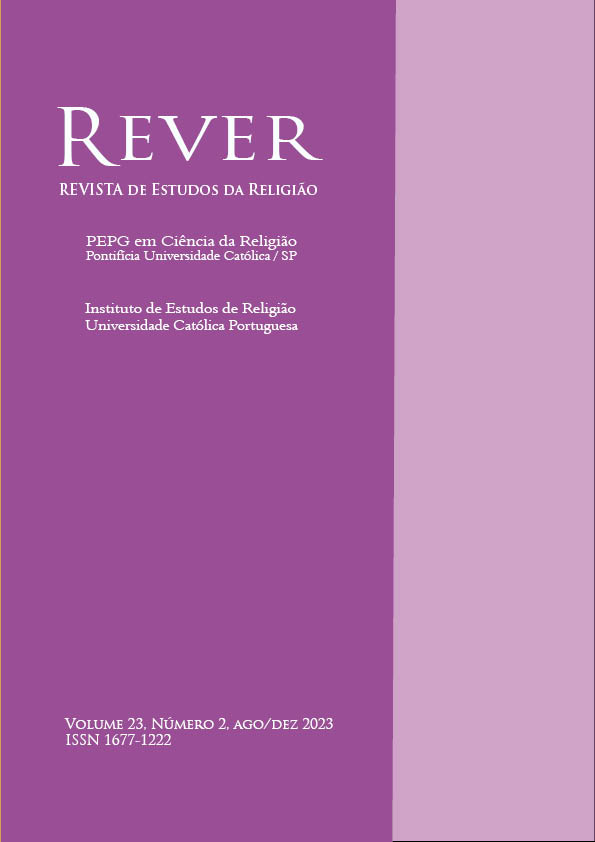Relações históricas entre o budismo e o hinduísmo no subcontinente indiano
DOI:
https://doi.org/10.23925/1677-1222.2023vol23i2a13Palavras-chave:
Budismo, hinduísmo, tensões religiosas, Índia, História da ÍndiaResumo
Hinduísmo e budismo compartilham uma série de elementos, a começar pelo nascimento no subcontinente indiano, passando por princípios, iconografia e até mesmo certas divindades. Enquanto o budismo declinou na Índia e se converteu em religião universal fortemente presente em vários países, o hinduísmo seguiu florescendo em seu território de origem. Este artigo sintetiza as relações históricas entre budismo e hinduísmo no subcontinente indiano, buscando entender como as semelhanças e as tensões, do século V AEC até nossos dias, plasmaram e plasmam ambas as religiões.
Referências
ANAND, M., “Buddhists fight for control of Mahabodhi temple”, in Rediff.com, artigo em mídia digital publicado em 17.04.08 e disponível em https://www.rediff.com/news/2008/apr/17bodhi.htm (c. 01.11.23)
BAILEY, G., MABETT, I., “The Sociology of Early Buddhism”, Cambridge: Cambridge University Press, 2004, p.108-137.
BUSWELL, Robert, e LOPEZ, Donald, "The Princeton Dictionary of Buddhism", 1ª edição, Princeton: Princeton University Press, 2014, 1265 p.
CROSBY, K., “Persecutions” in BUSWELL, R. (Ed.), Encyclopedia of Buddhism, New York: Thompson/Gale 2004, p. 640-647.
DESHPANDE, M., “Language and Legitimacy: Buddhist and Hindu Techniques”, in SUBRAMANIAM, V. (Ed.), Buddhist-Hindu Interactions from Śakyamuni to Śankarācarya, Delhi: Ajanta Books, 1993, p. 22-46.
GÓMEZ, L., “Buddhism in India”, in Encyclopedia of Religion, Vol. II, Detroit: Thompson/Gale 2005, p.1101-1131.
HALBFASS, W., “Der Buddha und seine Lehre im Urteil des Hinduismus”, in: SCHMIDT-LEUKEL, P. (Ed.), Wer ist Buddha? Eine Gestalt und ihre Bedeutung für die Menschheit, München: Diederichs, 1998, p. 176-194.
HAYES, F. RICHARD P., “A Buddhist’s Reflections on Religious Conversion”, Elijah School Lectures For the Fourth Summer Program, August 2000, p. 19.
HAZRA, K., “The Rise and Decline of Buddhism in India”, Delhi: Munishiram Manoharlal, 1995, p. 46.
KANTOWSKY, D., Buddhists in India Today: Descriptions, Pictures and Documents, Delhi: Manohar 2003, p. 156.
KHAN, M., “'Why are Hindus controlling the Mahabodhi temple?'”, in Rediff.com, artigo em mídia digital publicado em 27.07.17 e disponível em https://www.rediff.com/news/interview/why-are-hindus-controlling-the-mahabodhi-temple/20170725.htm (c. 01.11.23)
KLOSTERMAIER, K., “Hindu Views of Buddhism” in AMORE, R. (Ed.), Developments in Buddhist Thought: Canadian Contribution to Buddhist Studies, Waterloo: Wilfried Laurie University Press, 1979, p. 60-82.
KLOSTERMAIER, K., “Hindu-Buddhist Interaction in Twentieth Century India” in SUBRAMANIAM, V. (Ed.), Buddhist-Hindu Interactions from Śakyamuni to Śankarācarya, Delhi: Ajanta Books 1993, p. 171-187.
LOPEZ, D., “Buddha”, in Idem (Ed.), Critical Terms for the Study of Buddhism, Chicago and London, University of Chicago Press, 2005, p.13-36, especialmente p. 24ss.
MATTANANDO BHIKKHU, “The Role of Buddhism in Inter-religious Dialogue”, in Buddhist Himalaya: A Journal of Nagarjuna Institute of Exact Methods, Vol. II, N. 1 & 2, 1989, disp. em http://ccbs.ntu.edu.tw/FULLTEXT/ JR-BH/bh117496.htm (c. 29.12.08).
MINISTÉRIO DA LEI E DA JUSTIÇA DA ÍNDIA, “Constituição da Índia”, em https://legislative.gov.in/constitution-of-india/ (c. 30.10.23).
OFFICE OF THE REGISTRAR GENERAL & CENSUS COMMISSIONER, portal oficial disponível em https://censusindia.gov.in/census.website/ (c. 01.11.23).
RAJAN, V., “Education, economics and protest drive changes and reform to India's ancient societal divisions”, in Hinduism Today, 30.06.2003.
REYNOLDS, F., HALLISEY, C., “Buddhism: An Overview”, in Encyclopedia of Religion, Vol. II, Detroit: Thompson/Gale 2005, p.1087-1101.
SANTIKARO: Ajahn Buddhadasa and Inter-Religious Understanding, ND, artigo disponível em http://www.suanmokkh.org/archive/pdf/TW_2.pdf (c. 07.01.2009).
SCHMIDT-LEUKEL, P., “Buddhist-Hindu Relations”, in. Idem. (Ed.), Buddhist Attitudes to Other Religions, St. Ottilien: EOS 2008, p. 143-171.
SCHNEIDER, U., “Einführung in den Buddhismus”, Darmstadt: Wissenschaftliche Buchgesellschaft, 1992, p. 65-66.
SENEVIRATNE, K., “India: Conflict in the Cradle of Buddhism”, Inter Press Service English News Wire, 10.07.1996.
SMARTSCRAPERS, “Number of Ashrams in India”, disponível em https://rentechdigital.com/smartscraper/business-report-details/india/ashrams (c. 28.10.23).
STARK, R., “Why Religious Movements Succeed or Fail: A Revised General Model, Journal of Contemporary Religion”,
Downloads
Publicado
Como Citar
Edição
Seção
Licença

Este trabalho está licenciado sob uma licença Creative Commons Attribution-NonCommercial 4.0 International License.
Autores que publicam nesta revista concordam com os seguintes termos:
- Autores mantém os direitos autorais e concedem à revista o direito de primeira publicação, com o trabalho simultaneamente licenciado sob a Licença Attribution-NonCommercial 4.0 International, que permite o compartilhamento do trabalho com reconhecimento da autoria e publicação inicial nesta revista.
- Autores têm autorização para assumir contratos adicionais separadamente, para distribuição não exclusiva da versão do trabalho publicada nesta revista (ex.: publicar em repositório institucional ou como capítulo de livro), com reconhecimento de autoria e publicação inicial nesta revista.


